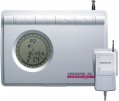How to connect the controller to the controlled device.
—
Wired. Connecting with wires is the most common option. It is due to its main advantages — simplicity, reliability and low cost. On the other hand, the wiring itself can be quite troublesome and time-consuming.
—
Wireless. Wireless connection — usually by radio channel. To do this, the kit usually provides an external transceiver connected to the controlled device. The main advantage of wireless models is obvious — they are much easier to install because no need to run extra wires. On the other hand, such a technique is much more expensive than wired, and communication has a limited range, which is further reduced if there are obstacles (such as thick walls) in the signal path.
—
DIN rail. The phrase "on a DIN rail" traditionally refers to the method of installing the device (see "Mounting"); the connection is usually carried out by wire. However, this option is taken out separately for the reason that DIN devices are standardly mounted in a distribution cabinet — unlike conventional wired
thermostats, installed directly in the room. However, sometimes it is an advantage: the distribution cabinet can be locked with a key, restricting unauthorized access to the thermostat. Models with such a connection usually refer to professional equipment used in industrial
...facilities, warehouses, etc.Automatic temperature control hysteresis provided by the device.
Hysteresis can be described as the difference between the on and off temperatures of a system controlled by a thermostat. Usually, the permissible deviations of the actual temperature from the nominal one in one direction or another are half the hysteresis. So, at a set temperature of 22 °C and a
hysteresis of 0.5 °C, the controller will turn on the heating as soon as the room temperature drops to 21.75 °C, and turn it off when it rises to 22.25 °C. Accordingly, the lower this indicator, the more carefully the temperature is maintained and the fewer fluctuations. On the other hand, small hysteresis values require accurate and expensive thermal sensors, increase fuel/energy consumption and wear of the entire system, and create an increased risk of false alarms (for example, from a cool draft on the thermal sensor). In addition, relatively small temperature fluctuations are practically imperceptible in terms of human comfort. Therefore, many modern thermostats have a
hysteresis of 1 °C — this, usually, is quite enough for domestic use.
Also note that this parameter can be both
fixed and
adjustable. The first option is simpler and cheaper, and the second provides additional options for setting the thermostat to the specifics of the situation.

